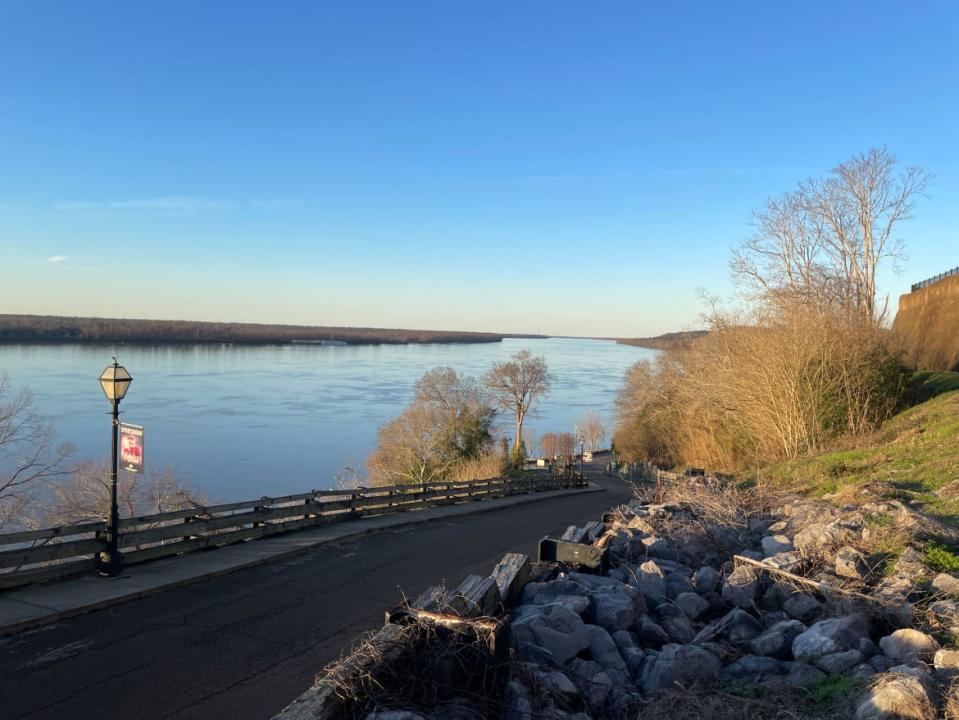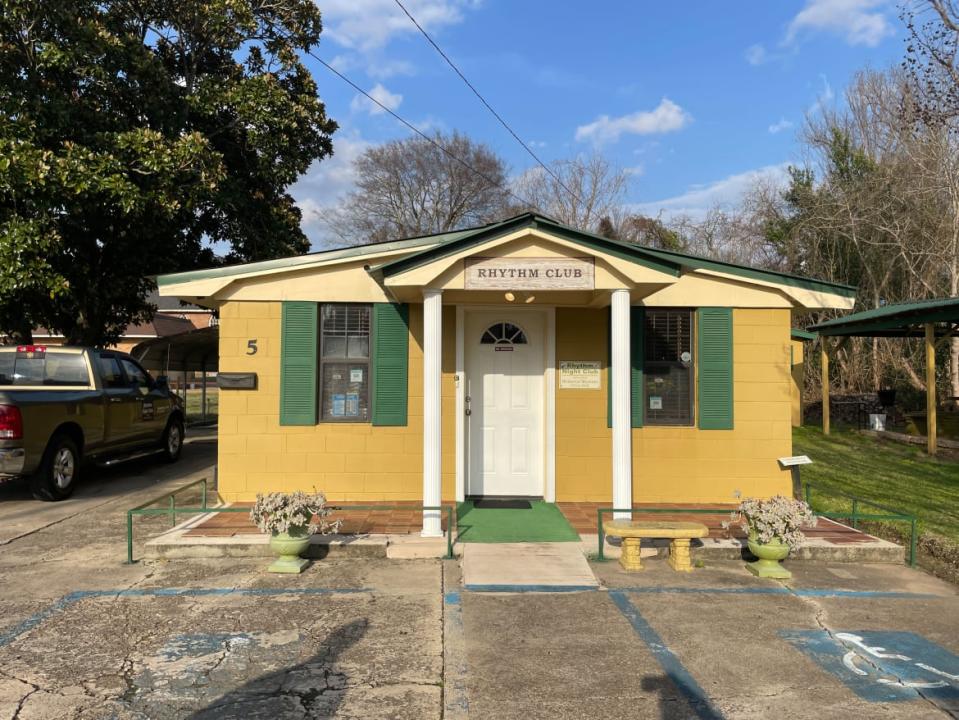One of America’s Beautiful Cities Leans Into Its Dark Past

As the sun sets on the mighty Mississippi River, locals and tourists stroll along the bluff with their dogs, pose for photos, or relax on benches taking in the sweeping spectacle. A spectrum of brilliant oranges, soothing pinks, and vivid violets paint the sky over the Miss-Lou Bridge connecting the port town of Natchez, Mississippi, with its neighbor, Vidalia, Louisiana. The river is a main character in the continuing story of Natchez, which is now reckoning with its unique and dramatic history of excessive wealth, unyielding cruelty, and transformative resistance.
Natchez sits in the southwest region of Mississippi along the river, a two-hour drive from New Orleans, Louisiana. It’s known as “the Little Easy,” acknowledging its big sister/little sister relationship. There’s plentiful historic and current connections between the two: for example, a shared love of Mardi Gras culture, especially the lavish, celebratory galas. The two cities housed the two largest slave auction sites in the United States. While New Orleans feels like a cosmopolitan metropolis, Natchez is a small town where everyone knows each other. There’s a genuine friendliness and ease with a Southern hospitality as sweet as the tea.
You’re liable to run into the mayor or local alderwoman doing site visits for the upcoming monument recognizing the contributions of non-white troops during the Civil War. There is a multi-faceted and concerted effort to honor the city’s Black history of resistance and excellence, as well as its deeply racist roots. Natchez was a capitalist center of slavery and home to those who built exorbitant wealth from it. Decades later it grew into a hotbed of violent activity for the Ku Klux Klan. In response, Natchez became nationally known as a site where armed struggle and peaceful protesting paved the way for major civil rights wins for Black residents.
Tourists are generally drawn to Natchez to visit massive antebellum homes on sprawling plantations that often tell a whitewashed sliver of its story. However, there’s a plethora of opportunities to go deeper, particularly by speaking with locals committed to preserving the history and telling the stories of their recent and distant ancestors who are a fundamental part of Natchez’s identity.

A great way to get acquainted with Natchez is via Rev’s Country Tours, led by Tracy A. Collins, affectionately known as “Rev.” He is jovial, knowledgeable, and deeply passionate about educating visitors, refusing to water down the history of what African-Americans endured in the region. “I use the antebellum homes here not to talk about the bricks and mortar, architecture, art, antiques but as a backdrop to ease people into a discussion about slavery because I think that’s the biggest story here and it’s the one nobody tells,” asserted Collins.
We started with a brief visit to the Grand Village of the Natchez Indians to understand the land from the lens of the indigenous people of the area. The cylindrical dirt mounds there were built centuries ago to honor the tribal chiefs of this matrilineal society; and a museum is open daily with various artifacts and crafts. Visiting this land provides context for Natchez’s founding and its legacy of resistance, exemplified in the Natchez Revolt of 1729 where the Natchez Indians massacred French colonizers after their once diplomatic relations soured.
Our next stop was Melrose Natchez National Historical Park, a site highlighting a restored antebellum house that is the only one in Natchez managed by the National Park Service. The foreboding cypress trees that line the entrance bore witness to the displays of tremendous wealth here, and the subjugation of the Black bodies who created it. The land contains slave quarters that were comparatively “upscale” (or more humane) compared to the lives of their counterparts who worked in the fields outside of Natchez. The slaves here were not picking cotton but instead taking care of the family and setting up parties for their aristocratic owners who were making beaucoup dollars in the business of slavery. Yet they always knew their fate was held in the whims of wealthy white masters. The mansion built in 1849 contains original pre-Civil War décor such as gold-lined chandeliers and fine china, as well as restored furniture. “Money says rich, gold says wealth,” explained Park Ranger Barney Scobey.
Our final stop was “Forks of the Road,” the site of the second-largest slave market in the country. Five different slave trader thoroughfares intersected there – routes by river and via foot which was the most popular (i.e. cheapest) mode of transportation for slave traders and most grueling for enslaved people. The site is marked with placards explaining the “business of slavery” with quotes from newspaper clippings inviting readers to “buy more Negroes to buy more cotton to buy more Negroes.” Although there are plans to memorialize the land more thoroughly, the eerily empty patch of land invites visitors to imagine the trauma inflicted there. The energy is palpable especially in the small concrete slab where chains and shackles like those used to bound humans are mounted. Even though they are replicas, it’s an effective visual tool to illustrate the sheer inhumanity of what happened there. Among the informational placards, one connects this chapter of Natchez’s story to the city’s powerful civil rights organizing of the 1960s.
Along St. Catherine Street, once a thriving corridor of Black businesses, there are numerous stops honoring Natchez’s role in the civil rights movement. Visit the Dr. John Bowman Banks Museum as part of the nationally designated Mississippi Freedom Trail. Dr. Banks was the first black physician in Natchez and a community leader who aided Black families during segregation and housed Booker T. Washington when he was in town. The house was also a safe space for local NAACP leaders including Charles Evers, brother of Medgar Evers, and is open for tours led by local volunteers who want to make sure his legacy is acknowledged.
The “Proud to Take A Stand” monument commemorates the hundreds of local Black activists who were imprisoned and tortured for participating in civil rights marches during 1965. Many were abused and tortured for days after peacefully demanding integrated schools and job opportunities. There’s also the site of the barbershop which was the home of the “Deacons of Defense,” an armed group of Black men who protected Black residents and businesses from the ongoing threats of the well-entrenched KKK. Spend some time doing a self-guided tour in the Natchez Museum of African American History and Culture.

One of the most evocative landmarks is the Rhythm Night Club Memorial Museum, where one of the country’s most deadly fires occurred. Though it happened in 1940, the tragedy impacted the entire Natchez community for generations and most locals have family members who survived or perished there. The Rhythm Night Club was a hot spot for dancing and live jazz music, and despite segregation it was a place where white and Black people would gather together. One night a cigarette ignited the highly flammable décor causing a massive fire that killed over 200 people. The magic of this museum is courtesy of the owner, Monroe Sago, who initially purchased this plot of land years ago to build his auto body shop. As he began construction, he kept hitting concrete and eventually found out that this was a historic site. By talking to other community members, he learned and uncovered the stories of survivors and those who died there. His passion for telling their stories is compelling as he walks you through a small but thorough museum full of photos, articles, and relics reflecting this moment of Natchez history.
While Natchez is full of undeniably intense stories, there’s a lot of joy and beauty. There is a thriving LGBTQIA+ community, bolstered by Y’all Means All Natchez, a nonprofit organization that supports mental health services and suicide prevention for local gay, queer, and trans youth. Despite the recent wave of homophobic and transphobic legislation sweeping the South, LGBTQIA+ travelers should feel safe to visit Natchez. Y’all Means All hosts regular community-building events and fundraisers but their annual Pride festival is the main event. Each fall, it brings hundreds from the Miss-Lou region featuring an epic drag ball, the “Battle of Belles and Beaus.”
There’s a plethora of food and shopping to experience in between tours. Enjoy a hearty and perhaps boozy brunch at The Little Easy or sample some locally-made flights at Natchez Brewing Company. Cross the street and head to Bluff Park’s various walking trails along the river that lead to a small stretch of restaurants and bars “under the hill.” Catch sunset there and grab a drink and some seafood at Magnolia Grill. Black-owned businesses are thriving such as the impeccably designed Guest House Hotel and Rolling River Reloaded serving up soul food classics (the fried broccoli appetizer is a standout). Walk around downtown and find some cute homegoods at Nest or Mother’s Apothecary. Lastly, don’t leave town without tasting some tamales at the festive Fat Mamas.
Get the Daily Beast's biggest scoops and scandals delivered right to your inbox. Sign up now.
Stay informed and gain unlimited access to the Daily Beast's unmatched reporting. Subscribe now.

